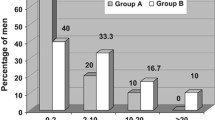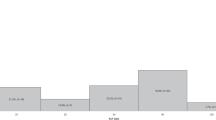Abstract
A population-based sample of 1673 (valid phenotypic and genotypic data were available from 1412 individuals) Finnish male twins and siblings of twins aged 18–45 years provided questionnaire data regarding ejaculatory function as well as saliva samples for genotype analyses. Genotypic analyses were conducted controlling for between-subjects dependence. No significant association was found between the 5-HTTLPR polymorphism and a composite variable measuring premature ejaculation or between this polymorphism and a self-report measure of ejaculation latency time. Previously conducted studies have found contradicting results regarding the possible role of 5-HTTLPR in premature ejaculation. Methodological inconsistencies have been pointed out in these studies, which have all been conducted on rather small samples. While differences in terms of measurement of ejaculatory function could partly explain why positive findings from some earlier studies could not be replicated, the present study, given the large sample size and multifactorial measures used, indicated that the 5-HTTLPR polymorphism has a limited, if any, impact on ejaculatory function.
Similar content being viewed by others
References
Althof, S. E., Abdo, C. H., Dean, J., Hackett, G., McCabe, M., McMahon, C. G., et al. (2010). International Society of Sexual Medicine’s guidelines for the diagnosis and treatment of premature ejaculation. Journal of Sexual Medicine, 7, 2947–2969.
Goldberg, T. E., Kotov, R., Lee, A. T., Gregersen, P. K., Lencz, T., Bromet, E., et al. (2009). The serotonin transporter gene and disease modification in psychosis: Evidence for systematic differences in allelic directionality at the 5-HTTLPR locus. Schizophrenia Research, 111, 103–108.
Greene, C. S., Penrod, N. M., Williams, S. M., & Moore, J. H. (2009). Failure to replicate a genetic association may provide important clues about genetic architecture. PLoS ONE, 4, e5639.
Gressier, F., Bouaziz, E., Verstuyft, C., Hardy, P., Becquemont, L., & Corruble, E. (2009). 5-HTTLPR modulates antidepressant efficacy in depressed women. Psychiatric Genetics, 19, 195–200.
Griffiths, A. J. F., Gelbart, W. M., Miller, J. H., & Lewontin, R. C. (2002). Modern genetic analysis: Integrating genes and genomes (2nd ed.). New York: W. H. Freeman and Co.
Janssen, P. K. C., Bakker, S. C., Réthelyi, J., Zwinderman, A. H., Touw, D. J., Olivier, B., et al. (2009). Serotonin transporter promoter region (5-HTTLPR) polymorphism is associated with the intravaginal ejaculation latency time in Dutch men with lifelong premature ejaculation. Journal of Sexual Medicine, 6, 276–284.
Jern, P., Santtila, P., Johansson, A., Varjonen, M., Witting, K., von der Pahlen, B., et al. (2009a). Evidence for a genetic etiology to ejaculatory dysfunction. International Journal of Impotence Research, 21, 62–67.
Jern, P., Santtila, P., Johansson, A., Varjonen, M., Witting, K., von der Pahlen, B., et al. (2009b). Subjectively measured ejaculation latency time and its association with different sexual activities while controlling for age and relationship length. Journal of Sexual Medicine, 6, 2568–2578.
Jern, P., Santtila, P., Witting, K., Alanko, K., Harlaar, N., Johansson, A., et al. (2007). Premature and delayed ejaculation: Genetic and environmental effects in a population-based sample of Finnish twins. Journal of Sexual Medicine, 4, 1739–1749.
Luo, S., Lu, Y., Wang, F., Xie, Z., Huang, X., Dong, Q., et al. (2010). Association between polymorphisms in the serotonin 2C receptor gene and premature ejaculation in Han Chinese subjects. Urologia Internationalis, 85, 204–208.
Nakamura, M., Ueno, S., Sano, A., & Tanabe, H. (2000). The human serotonin transporter gene linked polymorphism (5-HTTLPR) shows ten novel allelic variants. Molecular Psychiatry, 5, 32–38.
Ozbek, E., Tacsi, A. I., Tugcu, V., Ilbey, Y. O., Simsek, A., Ozcan, L., et al. (2009). Possible association of the 5-HTTLPR serotonin transporter promoter gene polymorphism with premature ejaculation in a Turkish population. Asian Journal of Andrology, 11, 351–355.
Pryor, J. L., Althof, S. E., Steidle, C., Rosen, R. C., Hellstrom, W. J. G., Shabsigh, R., et al. (2006). Efficacy and tolerability of dapoxetine in treatment of premature ejaculation: An integrated analysis of two double-blind, randomised controlled trials. The Lancet, 368, 929–937.
Rosen, R. C., McMahon, C. G., Niederberger, C., Broderick, G. A., Jamieson, C., & Gagnon, D. D. (2007). Correlates to the clinical diagnosis of premature ejaculation: Results from a large observational study of men and their partners. Journal of Urology, 177, 1059–1064.
Safarinejad, M. R. (2009). Polymorphisms of the serotonin transporter gene and their relation to premature ejaculation in individuals from Iran. Journal of Urology, 181, 2656–2661.
Safarinejad, M. R. (2010). Analysis of association between the 5-HTTLPR and STin2 polymorphisms in the serotonin-transporter gene and clinical response to a selective serotonin reuptake inhibitor (sertraline) in patients with premature ejaculation. British Journal of Urology International, 105, 73–78.
Safarinejad, M. R. (2011). Relationship between premature ejaculation and genetic polymorphisms of the dopamine transporter gene (SLC6A3). British Journal of Urology International, 108, 292–296.
Saiz, P. A., Garcia-Portilla, M. P., Herrero, R., Arango, C., Corcoran, P., Morales, B., et al. (2010). Interactions between functional serotonergic polymorphisms and demographic factors influence personality traits in healthy Spanish Caucasians. Psychiatric Genetics, 20, 171–178.
Santtila, P., Jern, P., Westberg, L., Walum, H., Pedersen, C. T., Eriksson, E., et al. (2010). The dopamine transporter gene (DAT1) polymorphism is associated with premature ejaculation. Journal of Sexual Medicine, 7, 1538–1546.
Schapiro, B. (1943). Premature ejaculation: A review of 1130 cases. Journal of Urology, 50, 37–40.
Sillanpää, M. J., & Auranen, K. (2004). Replication in genetic studies of complex traits. Annals of Human Genetics, 68, 646–657.
Waldinger, M. D., Berendsen, H. H. G., Blok, B. F. M., Olivier, B., & Holstege, G. (1998a). Premature ejaculation and serotonergic antidepressants-induced delayed ejaculation: The involvement of the serotonergic system. Behavioural Brain Research, 92, 111–118.
Waldinger, M. D., Janssen, P. K. C., & Schweitzer, D. H. (2009a). Hardy Weinberg Equilibrium in genetic PE research remains critical to avoid misinterpretation. Asian Journal of Andrology, 11, 524.
Waldinger, M. D., Janssen, P. K. C., & Schweitzer, D. H. (2009b). Re: Polymorphisms of the serotonin transporter gene and their relation to premature ejaculation in individuals from Iran: M.R. Safarinejad J Urol 2009;181:2656–2661. Journal of Urology, 182, 2983–2984.
Waldinger, M. D., & Olivier, B. (2005). Animal models of premature and retarded ejaculation. World Journal of Urology, 23, 115–118.
Waldinger, M. D., Quinn, P., Dilleen, M., Mundayat, R., Schweizer, D. H., & Boolell, M. (2005). A multinational population survey of intravaginal ejaculation latency time. Journal of Sexual Medicine, 2, 492–497.
Waldinger, M. D., Rietschel, M., Nöthen, M., Hengeveld, M. W., & Olivier, B. (1998b). Familial occurrence of premature ejaculation. Psychiatric Genetics, 8, 37–40.
Wendland, J. R., Martin, B. J., Kruse, M. R., Lesch, K. P., & Murphy, D. L. (2006). Simultaneous genotyping of four functional loci of human SLC6A4, with a reappraisal of 5-HTTLPR and rs25531. Molecular Psychiatry, 11, 224–226.
Wigginton, J. E., Cutler, D. J., & Abecasis, G. R. (2005). A note on exact tests of Hardy-Weinberg equilibrium. American Journal of Human Genetics, 76, 887–893.
Acknowledgments
We gratefully acknowledge the contributions of Prof. N. Kenneth Sandnabba and Prof. Pekka Santtila at the Department of Psychology and Logopedics at Abo Akademi University, Turku, Finland to the data collection and preparation of phenotypic data to this study. This research was supported by Grants No. 136263 and 138291 from the Academy of Finland, and a Center of Excellence Grant No. 21/22/05 from the Stiftelsen för Åbo Akademi Foundation.
Author information
Authors and Affiliations
Corresponding author
Rights and permissions
About this article
Cite this article
Jern, P., Eriksson, E. & Westberg, L. A Reassessment of the Possible Effects of the Serotonin Transporter Gene Linked Polymorphism 5-HTTLPR on Premature Ejaculation. Arch Sex Behav 42, 45–49 (2013). https://doi.org/10.1007/s10508-012-9991-x
Received:
Revised:
Accepted:
Published:
Issue Date:
DOI: https://doi.org/10.1007/s10508-012-9991-x




